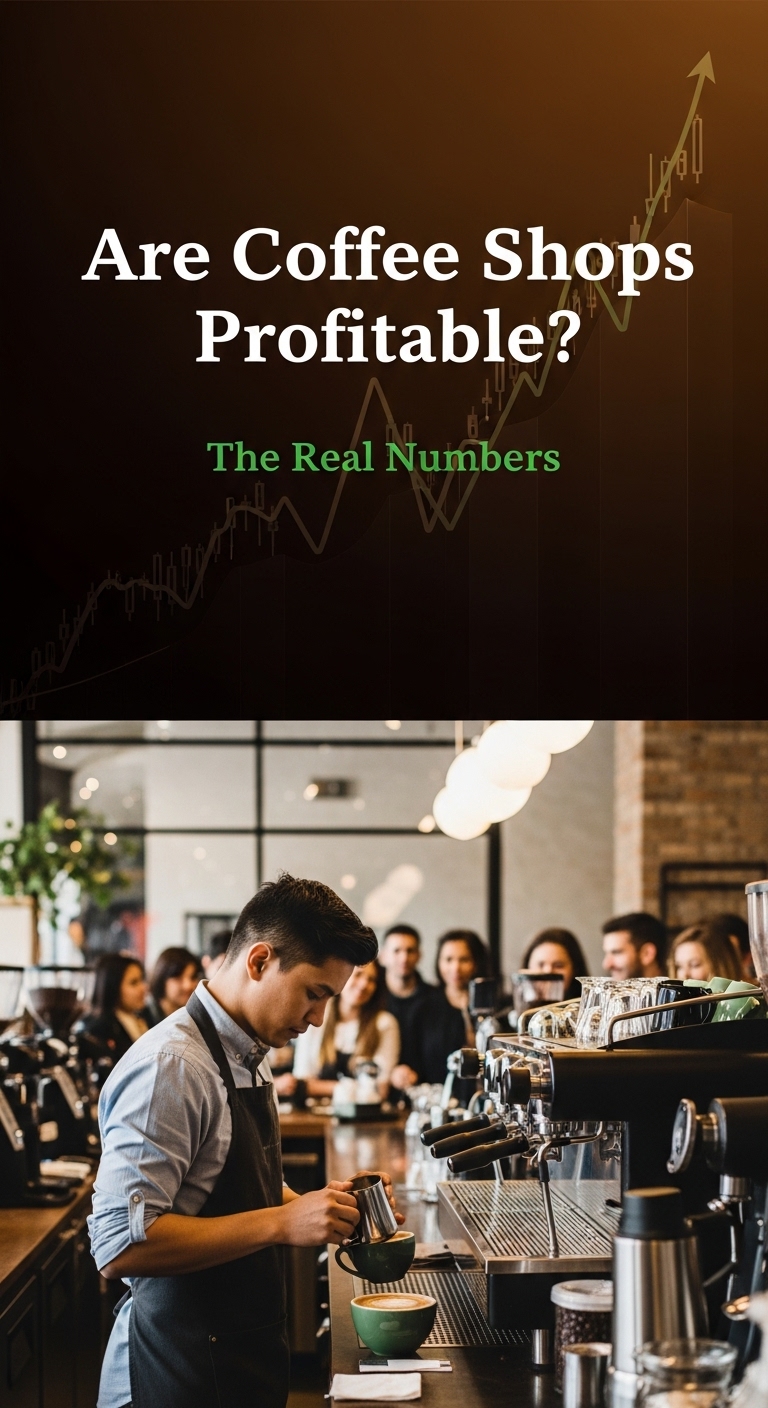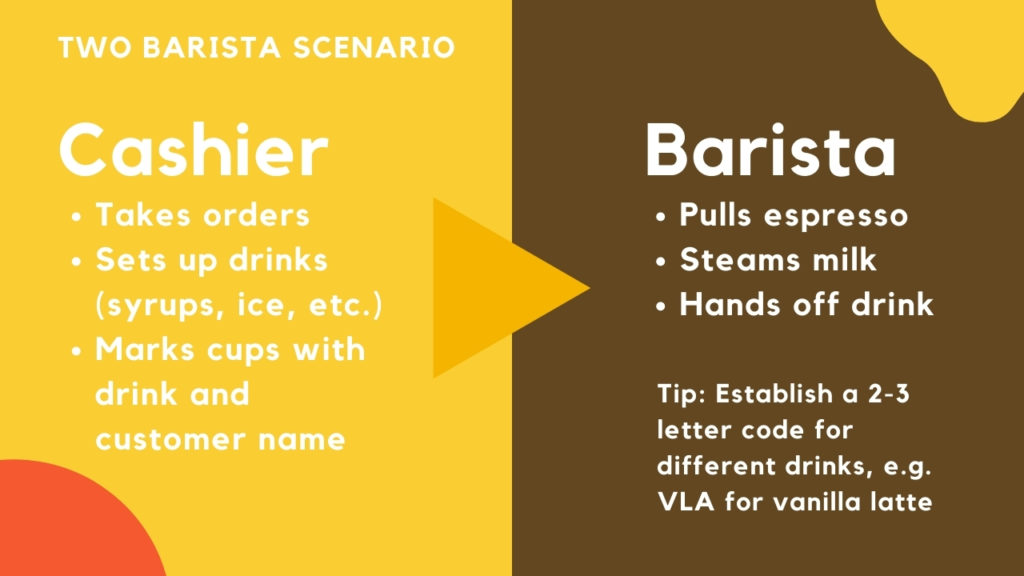As an Amazon Associate CoffeeXplore.com earns from qualifying purchases.
Are Coffee Shops Profitable? The Real Numbers
The idea of opening a coffee shop is a dream for many, evoking images of cozy corners, the rich aroma of espresso, and a bustling community hub. But beyond the romance lies a critical business question: can a coffee shop be profitable? Many aspiring owners wonder if their passion for coffee can translate into a financially sustainable and successful business.
Yes, a coffee shop can be profitable, with average net profit margins ranging from 5% to 15%. However, success is not guaranteed and depends heavily on meticulous financial planning, cost management, and strategic location. This guide unpacks the real numbers, proven strategies, and critical insights you need to navigate the path to profitability, leveraging extensive analysis of industry data and established patterns of successful cafes.
Key Facts
- Net Profit is Realistic, Not Extreme: While a single cup of coffee has a high markup, the overall net profit margin for a coffee shop business averages between 5% and 15% after all expenses are paid, according to data from sources like Esquires Coffee.
- Gross Margins Are Deceptively High: The gross profit on a single beverage can be extraordinary, often 65% to 95%. For instance, a cup of coffee that costs just £0.16 to produce can sell for £2.45, yielding a 93.5% gross profit.
- Labor and Rent are the Biggest Costs: The two largest expenses that eat into profits are labor (ideally kept under 30% of sales) and rent (ideally under 15% of sales), as highlighted in analysis by Seven Miles and Epos Now.
- Owner Income Varies Widely: A successful coffee shop owner’s annual income can range significantly, typically falling between $50,000 and $175,000 per year, depending on the shop’s revenue and overall profitability.
- Failure is a Significant Risk: Industry analysis from sources like Esquires Coffee indicates a high failure rate, with around 60% of independent coffee shops closing within five years, often due to poor financial management and a lack of a solid business plan.
The Big Question: Are Coffee Shops Profitable in 2025? (A Realistic Breakdown)
While the aroma of freshly brewed coffee is alluring, what do the actual numbers say about turning that passion into profit? Let’s dive in. The answer to whether a can a coffee shop be profitable is a nuanced one. Yes, it absolutely can be, but its success hinges entirely on a foundation of effective management, sharp strategic planning, and a clear understanding of market dynamics. Insights from authoritative sources like Esquires Coffee and Sage show that profitability isn’t an accident; it’s the result of a well-executed plan.

The core of the matter is this: a coffee shop can be profitable, but the journey requires moving beyond simply brewing great coffee to mastering the art of business. This means obsessing over costs, maximizing every sale, and creating an experience that keeps customers coming back. While the potential is there, it’s reserved for those who treat their cafe not just as a passion project, but as a serious business venture.
The Two Sides of Profit: Unpacking Gross vs. Net Margins
To truly understand if a can a coffee shop be profitable, you must first grasp the crucial difference between two types of profit: gross and net. Mistaking one for the other is one of the fastest ways to misjudge the financial health of your business.
Coffee shops have very high gross profit margins on drinks (often 65-95%), but the average net profit margin for the entire business is much lower, typically 5-15%, due to high operating costs.
Let’s break that down. Gross profit is what you make on a product after subtracting the direct cost of making it. As analysis from Dilworth Coffee and others points out, coffee is a fantastic product in this regard. A latte that costs about $1.12 in beans and milk might sell for $4.00, giving you a gross profit of $2.88. That looks amazing on paper.
However, net profit is the money you actually get to keep. It’s the percentage of revenue left after all expenses—rent, labor, utilities, marketing, insurance—are paid. This is where the sky-high gross margin meets the hard reality of running a business. Industry data compiled by Epos Now and letscogogo.com shows that this net margin typically settles in the 5% to 15% range, with many independent cafes hovering around the 10% mark.
| Profit Metric | Typical Range | Definition & Example |
|---|---|---|
| Gross Profit Margin | 65% to 95% | Profit after subtracting only the cost of goods (beans, milk, cup). For a £2.45 coffee costing £0.16 to make, the gross profit is 93.5%. |
| Net Profit Margin | 5% to 15% | Profit after subtracting all business expenses (rent, labor, utilities, etc.). This is the business’s actual profitability. |
Quick Fact: A single cup of coffee might have a 93.5% gross profit, but after paying all the bills, the business might only keep 10% of that sale as actual net profit.
What Are a Coffee Shop’s Biggest Expenses?
The primary reason for the dramatic drop from gross to net profit is the long list of operating costs. To run a profitable coffee shop, you must be a master of managing these overheads. The reality of running a cafe is that these expenses are constant and significant.
The largest expenses for a coffee shop are typically labor costs (ideally under 30% of sales), rent (ideally under 15% of sales), and the cost of goods sold (coffee, milk, food).
Based on data from multiple industry analyses, here is a breakdown of the major financial hurdles:
- Labor Costs: This is almost always the biggest expense. Staffing wages, taxes, and benefits can account for 20% to 40% of your costs. Successful shops work diligently to keep this figure below 30% of their total sales.
- Rent/Lease: Your physical location is a massive fixed cost. The common rule of thumb is to ensure your rent is less than 15% of your projected sales. A prime location costs more but can drive the volume needed to justify it.
- Inventory (Cost of Goods Sold – COGS): This includes all your raw materials—coffee beans, milk, syrups, alternative milks, pastries, sandwiches, and all paper goods like cups and sleeves. Purchases can easily make up 44.1% of your total costs, so managing waste and inventory is critical.
- Utilities: The espresso machine, grinders, refrigerators, ovens, and lighting are always running. Electricity, water, and gas are consistent monthly expenses.
- Equipment: While much of this is a startup cost, you must budget for ongoing maintenance, repairs, and eventual replacement of your expensive coffee machines and grinders.
- Marketing: Building a brand and attracting customers costs money, whether it’s through social media ads, local events, or loyalty programs.
How Much Money Can a Coffee Shop Actually Make? Revenue & Sales
After understanding the costs, the next piece of the profitability puzzle is revenue. So, how much money can a coffee shop actually make? The answer varies dramatically based on location, size, and business model, but we can look at averages to set a realistic baseline.
An average independent coffee shop can generate annual revenue between $100,000 and $500,000. Profitability depends on managing costs against this revenue, with owners potentially making between $50,000 and $175,000 yearly.
According to reports from sources like Sage, a small independent shop in the UK might see an annual turnover of £100,000 to £150,000. In the US, the range is broader, with Cafely and HotShot Sleeves noting annual revenues from $100,000 on the low end to over $500,000 for a busy, well-managed location.
To make this tangible for your own planning, you can forecast sales. Here’s a simple formula outlined by sources like Upmenu:
- Estimate the average amount a single customer will spend (Average Transaction Value).
- Estimate the number of customers you will serve each day.
- Multiply these two numbers, and then multiply by the number of days you are open per month.
For example, if you predict 100 customers per day who spend an average of $5.00 each, and you are open 30 days a month, your calculation would be:
100 customers/day × $5/transaction × 30 days/month = $15,000 in monthly revenue.

Pro Tip: Don’t just focus on getting more customers. The data shows that increasing the average receipt total through upselling is a key lever for boosting revenue.
The Blueprint for Profitability: 4 Key Strategies for Success
Analyzing the data from successful shops reveals a clear pattern. A profitable coffee shop isn’t just lucky; it executes a deliberate strategy. Transitioning from asking if a coffee shop can be profitable to how to make one profitable requires focusing on four key pillars. These best practices, derived from analysis by sources like Brisco Business and Seven Miles, form a blueprint for success.
To be profitable, coffee shops must focus on four key areas: 1) Strategic Location & Business Planning, 2) Menu Diversification & Upselling, 3) Strict Cost & Inventory Management, and 4) Delivering Consistent Quality & Service.
Which of these areas—cost control, menu innovation, or customer loyalty—presents the biggest opportunity for your potential business?
- Strategic Location and Impeccable Business Planning
- Location is King: A location with high foot traffic, great visibility, and easy access for your target demographic is non-negotiable. Proximity to offices, universities, or busy residential areas can make or break your business.
- The Business Plan: A comprehensive plan is your roadmap. It must include detailed financial projections, a clear brand identity, and a solid marketing strategy.
- Menu Diversification and Smart Sales Tactics
- Go Beyond Coffee: Diversify your menu with other high-margin items. Specialty teas, smoothies, fresh pastries, and grab-and-go lunch options can significantly increase your average sale.
- Train for Upselling: Teach your staff to consistently offer upsells (larger sizes, extra espresso shots) and cross-sells (pairing a coffee with a pastry). These small increases add up to substantial revenue over time.
- Relentless Cost and Inventory Management
- Track Everything: Implement a modern Point of Sale (POS) system to track sales data, monitor inventory, and manage staff scheduling.
- Minimize Waste: Meticulous inventory control, portioning, and regular stocktakes are essential to prevent spoiled food and wasted supplies from eating into your profits.
- Negotiate with Suppliers: Build good relationships with suppliers to negotiate better rates and explore bulk discounts as your volume grows.
- Unwavering Commitment to Quality and Service
- Consistency is Key: Your coffee must be excellent every single time. Inconsistent quality is a quick way to lose customers.
- Service Creates Loyalty: Friendly, efficient, and personal customer service transforms first-time visitors into loyal regulars. This creates positive word-of-mouth, the most powerful marketing tool of all.
1. Master Your Menu and Pricing
Your menu is your primary sales tool. A thoughtfully engineered menu can dramatically increase how much a coffee shop can make by encouraging customers to spend more on each visit. The strategy is twofold: offer more high-margin items and perfect the art of the upsell.
Boost revenue by diversifying your menu with high-margin items like specialty teas and food, and train staff to consistently upsell (larger sizes, extra shots) and cross-sell (pastries, sandwiches).
As sources like Pure Gusto and Epos Now emphasize, a profitable menu is a diverse one. Here’s how to put this into practice:
- Expand Beverage Options: Don’t stop at coffee. Add high-margin items like specialty teas, hot chocolate, fresh juices, and smoothies to capture a wider audience.
- Introduce Profitable Food Items: The easiest way to increase a check total is to add food. Partner with a local bakery for pastries or develop a simple in-house menu of sandwiches and baked goods. The strategy is to focus on items that have a good shelf life and require minimal preparation.
- Implement Upselling and Cross-Selling: This is a training issue. Your baristas should be comfortable and confident in asking simple questions like, “Would you like to make that a large for just 50 cents more?” or ‘pairing coffee with pastries’ by suggesting, “Our fresh almond croissant goes perfectly with that latte.”
- Leverage Seasonal Specials: Limited-time offers like a pumpkin spice latte in the fall or a peppermint mocha in the winter create urgency and excitement, driving sales and bringing in customers who want to try something new.
2. Control Your Costs Relentlessly
While boosting revenue is exciting, the true secret to making a can a coffee shop be profitable is relentless cost control. The most successful cafes are ruthlessly efficient operations where every dollar is accounted for. This discipline is what protects your net profit margin.
Effectively control costs through disciplined inventory management to minimize waste, negotiating better rates with suppliers, and optimizing staff schedules to match peak hours.
Insights from Brisco Business and Epos Now point to operational efficiency as a cornerstone of profitability. Here are the most impactful tactics:
- Master Inventory Management: Waste is a silent profit killer. Implement a “first-in, first-out” (FIFO) system for milk and food, conduct regular stocktakes to understand consumption patterns, and order supplies just-in-time to avoid spoilage.
- Optimize Staff Scheduling: Use your sales data to identify peak and slow periods. Schedule staff accordingly to avoid being overstaffed during quiet times, which kills your labor budget, and understaffed during a rush, which kills your customer service.
- Negotiate with Suppliers: As your business grows, you gain buying power. Don’t be afraid to regularly review prices with your coffee, milk, and food suppliers and negotiate for better rates or bulk discounts.
- Embrace Technology: A modern ePOS system is an essential investment for a profitable coffee shop. It provides the data you need to make smart decisions.
Utilize ePOS systems for sales tracking, inventory, and staff scheduling.
Why Do Many Coffee Shops Fail? (And How to Avoid It)
It’s a sobering but necessary reality to confront: the coffee shop business has a high rate of failure. A report from Esquires Coffee notes that around 60% of independent shops close their doors within the first five years. Understanding why they fail is the first step toward ensuring your venture succeeds. It’s easy to be a great barista, but running a profitable shop requires being an equally great business manager.
Many coffee shops fail due to poor financial management, underestimating high operating costs like rent and labor, a lack of a solid business plan, and intense market competition.
Based on analysis from multiple sources, including Epos Now and a LinkedIn industry report, the primary reasons for failure are almost always business-related, not coffee-related.
- Poor Financial Management: This is the number one killer. Owners underestimate startup costs, run out of operating cash, fail to track their expenses, and don’t understand their own profit margins until it’s too late.
- Lack of Business Acumen: Many owners are passionate about coffee but have no experience running a business. They lack a solid business plan, a marketing strategy, or the skills to manage staff and inventory effectively.
- Underestimating Operating Costs: New owners are often shocked by how quickly the costs of labor, rent, and utilities can erode their high gross margins. Without a tight budget, these expenses can spiral out of control.
- Intense Competition and Market Saturation: In many areas, the market is crowded. A new shop fails when it doesn’t have a unique selling proposition (USP) or a strong brand identity to differentiate itself from the dozens of other options available to customers.
- Inconsistent Quality and Service: Customers demand consistency. If the coffee is great one day and mediocre the next, or if the service is friendly one day and slow the next, customers will simply not return.
Equipping yourself with the right tools and supplies is a crucial first step in building an efficient and professional operation. Exploring a curated selection of coffee shop business supplies can help you find everything from high-quality brewers to essential point-of-sale systems.
FAQs About Coffee Shop Profitability
How long does it take for a coffee shop to become profitable?
While it varies, most independent coffee shops can expect to become profitable within the first few years of operation, assuming effective cost management and steady revenue growth. The initial phase involves significant startup costs and a period of building a customer base. Breaking even is the first milestone, with true, sustainable profitability often achieved in year two or three.
Can you really start a coffee shop with $100,000?
Yes, it is possible. A coffee kiosk or small coffee cart can cost between $90,000 and $150,000, while a small shop with seating may start at $100,000, making it feasible on the lower end. However, this would require very careful budgeting. A larger shop with a drive-thru and significant seating can easily cost $350,000 or more, so a $100k budget necessitates a smaller, more focused business model.
How much does an average coffee shop owner make a year?
A coffee shop owner’s annual income can vary widely, but a typical range is between $50,000 and $175,000 per year, depending on the shop’s revenue and profitability. This figure represents the owner’s salary or draws from the business’s net profits. Highly successful, multi-location owners can earn significantly more, while owners of struggling shops may earn very little in the early years.
Is a coffee shop in a small town profitable?
A coffee shop in a small town can be profitable, often benefiting from lower rent and less competition. Success depends on becoming a local hub and maintaining consistent quality and service. The key is to understand the local market. While foot traffic may be lower than in a big city, strong community ties can create an intensely loyal customer base, making a small-town cafe a very stable and profitable business.
The Bottom Line: So, Is Opening a Coffee Shop a Profitable Idea?
After reviewing the data, the costs, and the strategies, we can return to our core question: can a coffee shop be profitable? The answer is a clear and confident yes, but with a critical caveat. Profitability in the coffee industry is not a matter of chance; it is a matter of strategy, discipline, and execution. The allure of high gross margins on a cup of coffee is real, but turning that into actual net profit is a game of operational excellence.
The journey from a passionate coffee lover to a profitable business owner is paved with spreadsheets, inventory management, and marketing plans. It requires an owner to be as skilled in cost control as they are in pulling the perfect espresso shot. For those prepared to embrace both sides of the business, a coffee shop is more than just a dream—it is a genuinely profitable venture.
- Profit is in the Net, Not the Gross: Success lies in managing the 90% of revenue that goes to costs, not just celebrating the high markup on a single drink.
- Operations are Everything: Relentless control over labor, rent, and inventory is the single most important factor in achieving and sustaining profitability.
- Experience Builds Loyalty: Consistent quality and exceptional service are your best marketing tools, creating repeat customers who form the financial backbone of your business.
Armed with this realistic data, you can now move from asking ‘if’ a coffee shop can be profitable to planning ‘how’ to make yours a success.
Last update on 2025-12-06 / Affiliate links / Images from Amazon Product Advertising API

